IN A HURRY? CHECK OUT Anycubic Photon TOP PROS:
- Doesn’t require much assembly
- Simple setup
- Extremely detailed print quality
Looking to expand your collection of miniatures? Or are you looking for something that will help you create mods for your existing miniatures? 3D printing is the answer! But, you have to be careful because 3D printers come in all shapes and forms, and picking the right one can be difficult. To save you time and worry, we’ve decided to give you an in-depth guide about printing gaming miniatures and what are the best 3D printers for gaming miniatures.
Miniatures for tabletop games and RPGs are more complicated to print than regular 3D models because of the sheer amount of detail on the model. 3D Printing large objects such as walls, houses, castles, and bunkers can be achieved with almost any 3D printer. Unfortunately, printing a 28-millimeter miniature is a whole different can of worms.
Tabletop games may have dipped in popularity in the recent decade, but they still have a thriving community of die-hard fans. Regardless of whether you’re into wargames like Warhammer 40K or tabletop games like D&D, very few games can match the perfect mix of socialization and fun offered by this format.
One of the main reasons why the tabletop gaming has dropped in popularity are the high expenses involved in this hobby. This is even more true for war games. For example, a pack of 10 Space Marines will cost you 50 dollars, the paint is 30 bucks, and we can add 20 more bucks for additional materials, and cost racks up to 100 bucks for just one squad of space marines. Even though you can technically play with just one squad of humanities toughest warriors, it’s not as fun as with a 500 or 1000 point army consisting of predator tanks, dreadnaughts, and bike squads. To truly enjoy wargaming you have to invest a lot of money.
If you want to be successful in printing 3D miniatures, the first step is to buy a 3D printer that can get the job done. This sounds easy enough, but it’s not that simple. Most models on the market aren’t up to the task. What works for a designer or a teacher may not work for you. To get you up to speed, we’ve prepared a guide on everything you need to know about 3D printing gaming miniatures.
| IMAGE | PRODUCT | DETAILS | |
|---|---|---|---|
 |
Our #1 Choice
Anycubic Photon |
|
Check on Amazon |
 |
Monoprice Maker Select v2 |
|
Check on Amazon |
 |
FlashForge Creator Pro |
|
Check on Amazon |
 |
Wanhao Duplicator 7 v1.5 |
|
Check on Amazon |
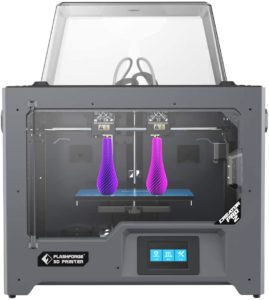 |
FlashForge 3D Printer Creator Pro2 |
|
Check on Amazon |
Before You Buy: Everything You Need to Know About 3D Printing Gaming Miniatures
When it comes to 3D printing miniatures, you should ground your expectations in several areas, including quality and cost. Things are not as simple as loading the filament into the printer and waiting for the carbon-copy of the miniature to come out of the build platform.
There are two types of 3D printers you can use for gaming miniatures: FDM and SLA 3D printers. Both come with a set of advantages and disadvantages you need to be aware of.
FDM 3D printers utilize an extruder with a hot end to melt plastic filament and deposit it onto a build platform one layer at a time. FDM printers are quite easy to use and usually have a big build area, which means they have a larger maximum build volume. Another advantage FDM printers have over SLA printers are their much lower operating costs. The post-print cleaning process is much easier than with SLA printers, although smaller models can be a nightmare to clean no matter what type of 3D printer you use. However, FDM printers are several steps behind SLA printers when it comes to print resolution and overall print quality. Don’t expect store-bought miniature quality from your 3D printed miniatures.
There are FDM printers that are more than capable of printing in high resolutions, however, a fully upgraded FDM printer will always be a level below an SLA 3D printer in the same price range.
FDM 3D printers are best used for terrains, houses, castles, and other large miniatures. Dual extruder FDM printers are excellent for building complex objects which have overhanging parts that need a significant amount of support materials.
SLA 3D printers, on the other hand, utilize a process in which a photopolymer liquid resin is exposed to a light source such as laser or digital light processing which causes it to harden. This process is repeated layer by layer until the model is finished. The process itself can be hazardous compared to FDM process and requires safety equipment.
In terms of advantages and disadvantages, SLA 3D printers are the opposite of the FDM 3D printers. SLA 3D printers are complicated to use and maintain. Furthermore, they have small build areas, which means limited build volume. They are also more expensive and have a higher operating cost than FDM 3D printers. On the bright side, SLA 3D printers build models with outstanding precision, producing high-resolution miniatures that are almost identical to those bought at a store. Also, this type of printer requires less calibration to produce the best results, unlike FDM printers that need calibrating after every couple of prints.
So, for which option should you go? It all depends on your preferences. If high resolution and outstanding print quality are your priorities, then you should go for an SLA 3D printer. If print size and operating costs are more important than the resolution and the quality of the print, then you should go for an FDM 3D printer. You should also consider getting an FDM printer if you want to print more than just gaming miniatures.
Why You Need The Best 3D Printer To Make Gaming Miniatures
Now that you’re familiar with what types of 3D printers you should use for 3D printing gaming miniatures, you may wonder why you should put so much effort into ensuring that you get the best model to make your miniatures. Some people think they can get away with buying the cheapest model on the market and hoping for the best, but this is, in most cases, the worst choice. Tabletop gaming veterans can attest to how many bad quality models can come out of cheap 3D printers.
There are many different models of 3D printers on the market, and all of them are ideal for a specific set of tasks. For instance, some of the largest 3D printers are designed to make large objects in excellent detail, but they lack the precision to make small objects in that same resolution.
If you want your miniatures to be perfect, you’ll have to get a 3D printer that is designed for precision tasks. Unfortunately, most 3D printers that can achieve a high level of detail come with an elevated price point.
If you plan on only making miniatures, you may also have an issue with the lack of experience with using a 3D printer. 3D printing is a skill that you’ll have to develop over time. Furthermore, it’s difficult to find a model that features the necessary precision for miniature making which is also user-friendly.
As you’ve already seen and will see, there are quite a few aspects that you’ll need to balance when making your purchase. This next section of the article will give you a fair rundown on what you need to look for when buying a 3D printer for gaming miniatures.
What to Look For In 3D Printers For Gaming Miniatures
If you’re new to the world of 3D printers, you may be having trouble identifying what are the most important features a 3D printer should possess to be viable for making gaming miniatures. Let’s go over the most important aspects to consider when buying a 3D printer to make gaming miniatures.
Precision
When looking for the perfect 3D printer to make your miniatures, the first thing you should look for is sufficient precision for your needs. Like we mentioned before, creating a detailed miniature means that 3D printer needs to be able to print objects at much higher resolutions than other models.
If you don’t manage to find a 3D printer with the right degree of detail, you’ll end up with a miniature that looks nothing like you’d expect it to look like. Keep in mind that your design can be as detailed as possible, but that won’t matter in the slightest if you get bottlenecked by your hardware. The hardware, in this case, is the 3D printer.
Keep in mind that high-resolution (precise) 3D printers will often cost more than printers that offer a lower resolution. Unfortunately, if you want to make miniatures, you can’t compromise precision for the sake of price. You need all the precision you can get in order for your miniatures to come out right.
Reliability
Even if you get the best 3D printer in the world, you won’t get much out of it if it’s constantly out of service. Reliability is on the most important features to look for in any 3D printer, whether or not they’re made for printing gaming miniatures, though such detail work tends to take a toll on the device.
You need much finer tolerances in a 3D printer that is designed for small detailed objects like miniatures. This means that they will suffer in the domain of reliability. Build quality is integral when you have such a tiny margin of error in your 3D printer, which runs up the operating costs even further.
When buying a new 3D printer, you should buy it from a company that has experience in the field because that will improve the reliability immensely. Buying 3D printers from unknown brands and companies could end up hurting you in the long run if the machine breaks down.
There is nothing enjoyable about sitting and worrying about whether or not your 3D printer will break down in the middle of the process. While more expensive models may end up costing you more up front, you may end up spending more on fixing a cheap 3D printer.
Nozzle Diameter and Layer Thickness
Nozzle diameter directly affects the precision of your 3D printer. You want to look for a model that has the smallest nozzle possible if you want to be successful at printing highly detailed gaming miniatures. The smallest nozzles available vary between 0.44 and 0.2 millimeters. However, there are more expensive models that come with even smaller nozzles.
The best solution is to find a 3D printer that has swappable nozzles. That way you will have more versatility in your 3D printing options. Please note that the smaller nozzle, the slower the print, but the higher the detail and overall quality of the finished miniature.
When it comes to layer thickness, the smaller the layers, the better. For printing gaming miniatures, you want to look for a model that can print layers that are 0.1-millimeter thick (or less). The logic here is that the thinner the layers, the more detail you’ll be able to get from your miniatures.
Material
When it comes to 3D printing miniatures, most people use ABS and PLA thermoplastics. While these materials are perfectly good for miniatures, they require a lot of post-processing. If you want to avoid this, you can look for a 3D printer that is more versatile than just ABS and PLA. We recommend you look for a model that can print other types of thermoplastics, wood, and ceramics. This will allow you to assimilate these materials right into the miniature, effectively cutting down the amount of post-processing.
Structure
3D printers come in many shapes and sizes, they are built out of different materials with different frame designs and structures. The materials and design of the 3D printer directly affect the print quality. You do not want to buy a model that features unstable, weak, or plastic parts that are prone to shaking when the printer is on. Not only does the structure of the printer affect the precision of the 3D printer, but it also affects the success of the print.
When looking for a 3D printer, try to set your sights on a model that is made out of metal as this will make the structure more stable and durable. The better the stability of your 3D printer, the more likely you will have miniatures with proper detailing.
Ease Of Use
3D printers are complex machines and not all of them are easy to operate. This is especially true if you’re new to 3D printing. If you are a beginner, we recommend you start off with a simpler model, even if that means sacrificing precision. There is no point in getting a $1000 3D printer if you’re going to spend more time fiddling with the settings than actually printing something.
If you’re an intermediate or expert user, then you have a wider range of models to choose from. If you’re a beginner and you don’t want to be limited by beginner-friendly models, you can start reading up and learning as much as you can about how 3D printers work. Only then should you consider getting a more advanced 3D printer.
At the end of the day, the user-friendliness of any particular 3D printer depends on your willingness to learn how to use it and whether or not you have experience in 3D printing. If you want your gaming miniatures to come out perfect every time, you better be prepared to learn. You will have to learn sooner or later, so why not sooner?
Extra Features
3D printers in higher price ranges come with lots of features that make your job easier as a user. For instance, some models feature a touchscreen instead of buttons, so you don’t have to break your head learning the right button combinations.
Beyond that, some models also come with a filament detection system that alerts you when you’re running low, making refills more convenient. Some models feature pre-constructed filament cartridges, so you don’t even have to worry about threading it yourself.
One other cool feature some printers have is the failsafe system. This system allows the 3D printer to resume printing exactly where it left off if the process gets interrupted by lack of printing material or by a power outage.
Best 3D Printer Settings For Gaming Miniatures
One of the best ways of determining which type of 3D printer you need is to look at what category of miniatures you would like to make. Even though some 3D printers are more than capable of creating terrain and miniatures all at once, it doesn’t mean they will do a particularly good job at any of them. So, if you are planning on making a specific category of miniatures, you will want to buy a 3D printer that features optimal settings for that specific category. Let’s go over each category and give you advice on what printer is the best for that category.
Terrain Pieces, Landscapes, and Props
If you’re planning on making large terrain pieces, prop replicas or landscape props, we recommend you go for an FDM 3D printer. FDM 3D printers are best suited for this task because they can print details down to 0.1 millimeters and up perfectly, but also have ample build space to create large prints.
We recommend you look for FDM 3D printers that offer a build volume of 200 x 300 millimeters or larger. The reason behind this is that these printers will give you enough space for those large replica pieces such as buildings, bridges, bunkers, and fences.
Miniatures
If you’re planning on making miniatures that are 54 millimeters in height, it’s generally a good idea to go for an FDM 3D printers since they are more than capable of printing large to medium details you need and at an affordable cost. However, you will have to spend a lot of time on post-processing like painting and sculpting to get those fine details in.
If you don’t want to lose time on processing but still want your miniatures to have intricate details, you should invest your money in an SLA 3D printer. However, these printers come with a catch. If you plan on making miniatures that are larger than 54 millimeters, you will start burning through your resin supply quickly. And, 3D printer resin isn’t cheap.
Detailed Figurines
If you want to make miniatures that are between 28 and 54 millimeters in height, not only will you need a lot of patience but you will also have to invest in a decent SLA 3D printer. However, if you don’t mind adding fine details by hand, you can go for a mid to high-end FDM printer. But keep in mind that if you’re planning on making models that have lots of overhangs you will have to go for an SLA 3D printer because it doesn’t require any support structures.
Always prioritize build and print quality over the size of the objects. Larger objects such as landscapes, props, and terrain pieces can always be broken down into smaller parts, and then assembled after they’re printed. Segmenting your builds will allow you to get the best quality of your 3D printer without sacrificing anything but time and patience.
The 5 Best 3D Printers For Gaming Miniatures
Now that you are familiar with what type of printers are best for making gaming miniatures, you can take a look at our list of best models on the market. In this guide, we’ll introduce you to both FDM and SLA models that are under $1000. We hope you find it helpful in your search for the best 3D printer for your needs.
1. Anycubic Photon
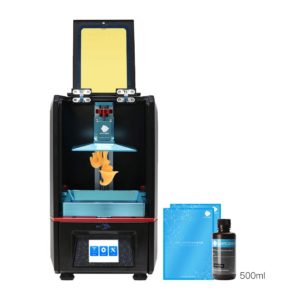
The Anycubic Photon is a DLP 3D printer that can print miniatures in stunning detail. The Photon is able to produce more detailed miniatures than the Wanhao Duplicator 7 v1.5, which is also in the same price range. It features a maximum layer resolution of 25 microns, which is amazing for such an affordable device.
Although the Photon is marketed as a DLP (digital light processing) SLA (stereolithography) 3D printer, it’s actually an LCD SLA 3D printer that uses a UV LED light source to harden the resin. Just like any resin-based 3D printer, the Photon prints objects from top to bottom, which is opposite to the process of an FDM 3D printer. Although it’s not a true SLA machine, the Photon can still print extremely detailed and smooth miniatures including the most complex ones.
This 3D printer features a build volume of 115 x 65 x 155 millimeters, which is just perfect for miniatures. If you want to print bigger objects such as terrain props or buildings, you might be better off with an FDM 3D printer or a larger SLA printer.
The Photon comes out pretty much assembled out of the box. The windows on the 3D printer are protected by plastic sheeting, while styrofoam is inserted in the print chamber to keep things from wiggling while in transport. The Photon features a sturdy frame, with a touchscreen interface that allows you to see a preview of the model you’re about to print. It also comes with a user-friendly slicer and features an easy bed leveling process.
One thing you must keep in mind about this printer (and any other SLA printer) is that the cleaning process can be tricky. While you won’t have to sand down the printed miniature or anything like that, you will be working with hazardous materials. The post-processing involves cleaning the pieces with ethanol, curing them, and cleaning the build plate. It is a very messy process. Also, the resin has a very unpleasant smell, so we recommend you wear gloves and a mask and work in a well-ventilated area.
Pros
- Doesn’t require much assembly
- Simple setup
- Extremely detailed print quality
- Touchscreen interface
Cons
- Expensive material
Bottom Line
If you are planning on making super-detailed miniatures that will leave everyone dumbfounded, then the Anycubic Photon is the right choice for you. It is the best 3D printer for the job. The only drawback to this model is the cleaning process and the running costs, but no one can have the cake and eat it too.
2. Monoprice Voxel 3D Printer
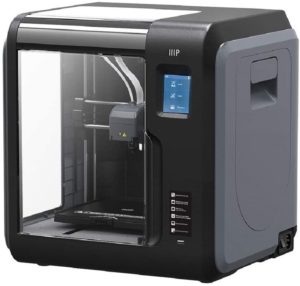
The Voxel 3D printer is a unique, easy-to-use, and beginner-friendly 3D printer. What endears us to this printer is its simple menu system. This menu system is displayed on a 2.8″ color IPS touch screen. It has a leveling system that minimizes calibration to a single tap on the touch screen. The print nozzle of this 3D printer can be removed without the use of any tools.
This 3D printer has 8GB of internal memory, a USB port, a WIFI radio with a hotspot, and a customized built-in camera to capture printing operations. Removing a print model is super easy with this product, this is possible because of the flexibility of the build plate. To remove a model, all that is needed is to flex the model to dislodge it. If a model becomes damaged, it can easily be replaced in a second build plate.
Using the polar cloud feature, you can control this 3D printer remotely from any location via the Internet. You can connect and monitor several printers at once, slice models, and even read the latest news about 3D printing!
The makers of this product have amazing customer service and support. They have a team of skilled and knowledgeable technicians ready to answer various questions from customers at any given moment of the day.
Pros
- Auto-leveling: it’s possible to adjust the distance between the nozzle and the heating bed via the touch screen interface.
- Auto feeding with filament sensor: this makes loading of filament simple and easy. It has a sensor that recognizes low filament levels. It will stop print until the filament is reloaded.
- Quick nozzle change: unlike other 3D printers that take a lot of time to replace the nozzle, with this printer, you can replace the nozzle in seconds!
Cons
- The filament compartment doesn’t take a standard filament roll.
Bottom line
It’s a decent printer to have. If you are new to printing, you would find this printer highly beneficial. Although it is somehow pricey at $400, it offers great value for its price. It is highly recommended.
3. FlashForge Creator Pro
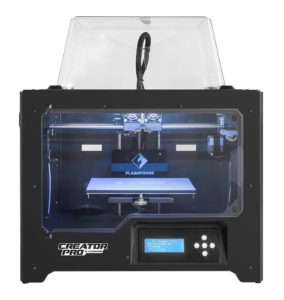
A dual extruder 3D printer allows you to use a second filament for support material. This second filament is dissolvable in either water or ethanol. This allows you to print very complex miniatures with multiple overhangs without the issue of supports leaving witness marks on your final print.
Another advantage to dissolvable supports is that they greatly reduce the amount of time and effort you’ll need to clean your miniature once it’s finished printing.
The FlashForge Creator Pro is one such 3D printer. It is able to reliably print miniatures as small as 28 millimeters, but it won’t be able to replicate the finest details. This is particularly true for facial details like eyes, mouth, and ears. However, this is the issue with almost every FDM 3D printer on the market, they are just unable to replicate the level of detail that an SLA 3D printer can.
The Creator Pro is essentially a clone of the very popular Makerbot Replicator 3D printer. However, this printer is three times cheaper than the Makerbot and comes with the huge benefit of having all the user enhancements that were commonly done to the Makerbot model already included as a standard.
Enhancements like the metal support arms for the build plate that provide much better thermal stability and prevent it from moving around during the build. It also comes with plastic coated adjusters that make leveling the build plate a breeze.
The Creator Pro features a CPU with the power necessary to install Sailfish firmware. This firmware is a great enhancement because it gives you the ability to auto-level the print bed, more precise heater control and a much higher print quality due to the prioritized timing of CPU operations. All these features added up make the Creator Pro a highly accurate and reliable 3D printer that’s perfect for making larger figurines.
The chassis on this model is fully enclosed, which allows you to reliably print with ABS filament so you can take advantage of the superior finish and strength only this material can provide.
Pros
- It’s a replica of the popular Makerbot Replicator but at one third the cost
- Easy to set up
- A wide variety of aftermarket mods
- Excellent print volume
- Excellent print quality
- Dual extruders
Cons
- It’s not precise enough to replicate the fine details on the miniature
Bottom Line
If you are looking for a decent FDM 3D printer that can build both large and small miniatures, then the Creator Pro is an excellent choice for you. Even though it struggles with the fine details, it makes it all up with the dual extruders. You will be able to produce stunningly complex miniatures that have lots of overhangs, all thanks to the second nozzle.
4. Wanhao Duplicator 7 v1.5
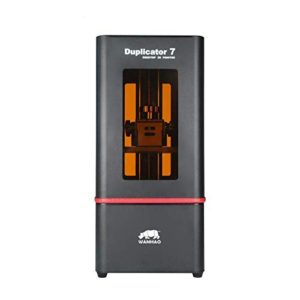
The Wanhao Duplicator 7 v1.5 is a DLP 3D printer, which means that instead of melting plastic filament it uses UV light to cure the liquid resin. Since its launch, the Wanhao Duplicator 7 (or just D7 for short) caused quite a commotion in the 3D printer market because of its affordable price and superb print quality. This 3D printer is perfect for making intricately detailed miniatures, especially those of 28-millimeter variety.
The specifications on the D7 don’t differ much from other similar DLP 3D printer models. It has a 12 x 68 x 180-millimeter build volume and a layer resolution of only 35 microns, which is perfect for reproducing the fine details on the miniature. It comes fully assembled out of the box, with you only having to mount the build plate and pour the resin in the tank.
It connects to your computer via USB and requires a specialized application to be able to run properly. Thankfully, you can use an open source application like ManoDLP. We recommend you get a Raspberry Pi 3 and install the application on so you can free up your computer from 3D printing duties.
Wanhao offers a wide range of resins for the D7. A bottle will cost you around 40 dollars. Of course, you’re not limited to the resins provided by the manufacturer. If you want to buy resins from other manufacturers, just make sure they are working with an active wavelength of 405 nanometers.
Thankfully, the Wanhao Duplicator 7 has a thriving community of users that are constantly sharing their experiences. They made an exhaustive list of all brands of resins you can use with this 3D printer which you can check out here[https://3dprinterwiki.info/d7/d7-resin-information/]. You can always check out the facebook page for helpful tips, tricks, and solutions for issues you might encounter.
Pros:
- Extremely detailed print quality
- Huge and helpful community
- Extremely affordable
- Sturdy frame
- Larger print volume than the Anycubic Photon
Cons:
- The resins can get expensive
- Can’t print large objects
- Unreliable customer support
Bottom Line
If you are looking for a resin-based 3D printer that offers a larger build volume than the Anycubic Photon, the Wanhao Duplicator 7 v1.5 is a perfect choice for you! It’s a reliable 3D printer that will impress you with its ability to build extremely detailed miniatures. It’s relatively easy to use, has a helpful user community, and comes with a bottle of resin so you can start printing right away.
5. FlashForge 3D Printer Creator Pro2

This product is an amazing dual extruder 3D printer. The extruder diameter is 0.4mm and the print speed is in the range of 10-100mm/s. It has a touch screen and the net weight is 15kg. The product has an anti-scrape design. This prevents scrap in the process of printing, which automatically leads to better printing results.
It has four different modes you can choose from, which are: mirror mode, duplicate mode, dual-color printing, and dual filament printing mode. Out of this four-mode, you can select the mode that suits your needs. Rapid steady heating does not allow warping of models.
This product is suitable for different printing filaments such as; PLA, ABS, PETG, TPU, and so on. This product is also suitable for industrial design, tool design, architecture design, and many more. Buying this product puts your mind at rest because the manufacturer offers a 1-year warranty, lifetime technical assistance, and 24 hours professional customer service.
The product has powerful 3D slicer support. This slicer support works with Flashprint software, this software allows for easy 3D slicing. This also ensures quick and better printing.
Pros
- Independent dual extruders: it has various 3D printing modes which are: mirror mode, duplicate mode, dual filament mode, and dual-color mode
- Wide 3D printing materials compatibility: it’s compatible with PLA, ABS, PVA, and PETG filaments
- 5-inch touch screen: this feature helps in setting up 3D printing accurately
Cons
- It is not budget-friendly
- No removable build
Bottom line
If you are on a low budget for a 3D printer, this printer is not meant for you. Although the product is quite pricey, it is a printer that solves almost all problems as regards 3D printing. From the reviews, we noted quite a lot of people who bought the product are in love with it. Though it has some cons, it is highly recommended.
So what do you think about printing 3D miniatures? Is it moral to print WH40K or D&D miniatures for your personal use? Do you own any of the products listed above? Let us know in the comments below!
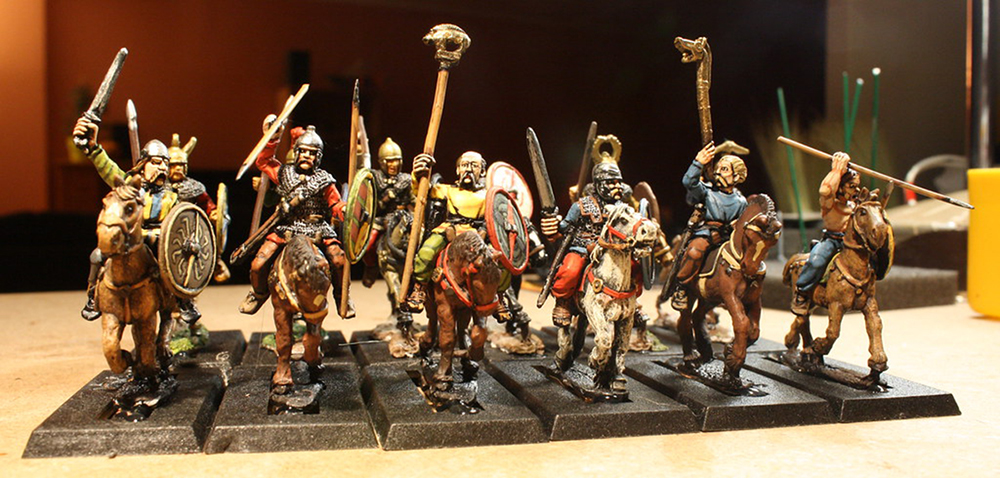
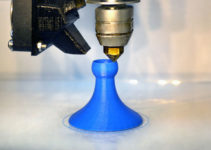
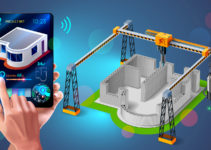
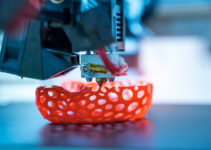
No Responses